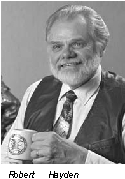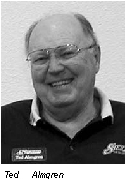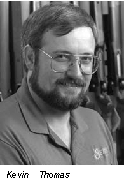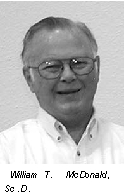Robert Hayden
 Bob Hayden was born and raised in Kansas City, MO. He became interested in shooting sports at the early age of ten, and the areas surrounding Kansas City offered the setting for a lot of great hunting with both rifle and shotgun. Bob graduated from Finley Engineering College, Kansas City, in 1960 with a Bachelor of Science degree in Mechanical Engineering. He began employment with the Remington Arms company at the Lake City Ammunition Plant in Independence, MO, the same year. During nearly ten years with Remington, Bob Robert Hayden worked as a ballistics engineer and ballistician, process engineer, and production manager. He was instrumental in the development of the National Match ammunition and the military 5.56mm service round. Bob joined the Leisure Group in the fall of 1969 as Manager of Operations at Sierra Bullets.
Bob Hayden was born and raised in Kansas City, MO. He became interested in shooting sports at the early age of ten, and the areas surrounding Kansas City offered the setting for a lot of great hunting with both rifle and shotgun. Bob graduated from Finley Engineering College, Kansas City, in 1960 with a Bachelor of Science degree in Mechanical Engineering. He began employment with the Remington Arms company at the Lake City Ammunition Plant in Independence, MO, the same year. During nearly ten years with Remington, Bob Robert Hayden worked as a ballistics engineer and ballistician, process engineer, and production manager. He was instrumental in the development of the National Match ammunition and the military 5.56mm service round. Bob joined the Leisure Group in the fall of 1969 as Manager of Operations at Sierra Bullets.
Over the years, Bob has been the driving force in production machine design, bullet development, and the development of Sierra’s Reloading Manual publications, in addition to his normal responsibilities as Executive Vice President and now as President of the company. Bob has managed Sierra for 33 years and was instrumental in the planning and execution of Sierra’s move to Missouri.
Ted Almgren
 Ted was raised in a small Northern California town, attending one-room schools and hunting and fishing for recreation. He put those things in life aside for a few years while he obtained a bachelor’s degree in mathematics from California State Polytechnic University in San Luis Obispo in 1960. He went to work for what was then North American Aviation, which eventually became Rockwell International. He retired from there to Montana almost 35 years later as the Chief Systems Engineer for Advanced Command and Control Systems. His primary experience was in the Nuclear Command and Control and Nuclear Safety Areas utilizing computer systems and software.
Ted was raised in a small Northern California town, attending one-room schools and hunting and fishing for recreation. He put those things in life aside for a few years while he obtained a bachelor’s degree in mathematics from California State Polytechnic University in San Luis Obispo in 1960. He went to work for what was then North American Aviation, which eventually became Rockwell International. He retired from there to Montana almost 35 years later as the Chief Systems Engineer for Advanced Command and Control Systems. His primary experience was in the Nuclear Command and Control and Nuclear Safety Areas utilizing computer systems and software.
In 1965, he purchased a new rifle for hunting and found that there were no ballistics tables for bullets other than those for factory cartridges in manufacturer marketing materials. Given this lack of data and the ready availability of high-tech computers, in 1968 he wrote his first computer program to compute small arms bullet trajectories from the data in Hatcher’s Notebook on the Ingall’s Tables. Later that year, after Bill McDonald explained to him how they could jointly make it better, he and Bill approached Sierra Bullets about how they computed Ballistic Coefficients. The discussions from that meeting led to a number of significant events. Ted and Bill have collaborated on the Exterior Ballistics sections of all Sierra Reloading Manuals and the initial Lyman Cast Bullet and Black Powder manuals. The initial 1968 exterior ballistics software progressed into a FORTRAN program that generated all the reloading manual tables and BASIC programs for Sierra 1, 2, the mathematics for Sierra 3 and the current Sierra Infinity software. In 1971, Ted and Bill first began measuring Ballistic Coefficients for Sierra (and other bullets) using the chronographs in the Sierra 300-yard underground test range and their ballistics coefficient software rather than using the Coxe & Beuglass tables. Today, all Ballistics Coefficients published by Sierra are those measured in the new Sierra 300 meter underground range in Sedalia, MO.
Ted and Bill became associated with AFTE when AFTE measurements at the Black Canyon field tests indicated an error in Ballistic Coefficient measurements for one of Sierra’s 30 caliber bullets. That error pointed to a consistent hardware problem with the Sierra hardware in the old Sierra range that led to new hardware in the new range. Ted and Bill have supported the AFTE tests at Yuma as independent advisors since their inception.
Kevin Thomas
 Spending his early years in Southern California, Kevin Thomas has been an avid shooter and student of firearms as far back as he can remember. Enlisting in the military immediately after high school, Kevin served four years in the U.S. Army, assigned to an Infantry Company with the 101st Airborne Division. His interest in marksmanship was noted by his commanding officer, and he was sent to and graduated from one of the first sniper schools to be taught by the division since the Vietnam war had ended. During that time, he also received his first exposure to for- Kevin Thomas mal competitive shooting, eventually spending nearly three years assigned to the 101st Marksmanship Training Unit (MTU). As part of his “duties” he engaged in NRA HighPower and Long Range competition, in which he holds a Master classification. After his military service, Kevin returned to Southern California, where he became a police officer in Los Angeles County. Combat Pistol IPSC/USPSA competition became Kevin’s primary competitive interest at that time, although he continued to shoot regularly at many of the area’s HighPower rifle matches. Frequently giving testimony or consultation on many criminal and civil court cases, Kevin became a court-accepted expert in the field of firearms and ballistics. He left law enforcement after six years, starting with Sierra in 1987 in the production department. Working with Sierra’s Chief Ballistician Martin (Jim) Hull, Kevin was one of the first technicians answering calls on the newly formed “tech-line.” Kevin took over as Manager of the Ballistic Service upon Hull’s retirement in 1989 and was promoted to Chief Ballistician in 1992. Since relocating to Missouri, he has continued to shoot a wide variety of disciplines, including HighPower, Rifle and Handgun Silhouette, USPSA Practical pistol and NRA Action pistol. At this writing, Kevin holds current classifications in at least eight different competitive disciplines (both rifle and pistol), and is a life member of both the NRA and the USPSA.
Spending his early years in Southern California, Kevin Thomas has been an avid shooter and student of firearms as far back as he can remember. Enlisting in the military immediately after high school, Kevin served four years in the U.S. Army, assigned to an Infantry Company with the 101st Airborne Division. His interest in marksmanship was noted by his commanding officer, and he was sent to and graduated from one of the first sniper schools to be taught by the division since the Vietnam war had ended. During that time, he also received his first exposure to for- Kevin Thomas mal competitive shooting, eventually spending nearly three years assigned to the 101st Marksmanship Training Unit (MTU). As part of his “duties” he engaged in NRA HighPower and Long Range competition, in which he holds a Master classification. After his military service, Kevin returned to Southern California, where he became a police officer in Los Angeles County. Combat Pistol IPSC/USPSA competition became Kevin’s primary competitive interest at that time, although he continued to shoot regularly at many of the area’s HighPower rifle matches. Frequently giving testimony or consultation on many criminal and civil court cases, Kevin became a court-accepted expert in the field of firearms and ballistics. He left law enforcement after six years, starting with Sierra in 1987 in the production department. Working with Sierra’s Chief Ballistician Martin (Jim) Hull, Kevin was one of the first technicians answering calls on the newly formed “tech-line.” Kevin took over as Manager of the Ballistic Service upon Hull’s retirement in 1989 and was promoted to Chief Ballistician in 1992. Since relocating to Missouri, he has continued to shoot a wide variety of disciplines, including HighPower, Rifle and Handgun Silhouette, USPSA Practical pistol and NRA Action pistol. At this writing, Kevin holds current classifications in at least eight different competitive disciplines (both rifle and pistol), and is a life member of both the NRA and the USPSA.
William T. McDonald, Sc.D
 Bill is a consultant in the fields of instrumentation engineering and ballistics of small arms. He received Bachelor of Science (1957) and Master of Science (1958) degrees in Electrical Engineering from the California Institute of Technology, and a Doctor of Science degree in Instrumentation (1968) from the Massachusetts Institute of Technology. Bill has worked for more than 40 years in instrumentation development for navigation and guidance of aircraft, missiles, and spacecraft, for technical intelligence collection, and for growth and examination of protein William T. McDonald, crystals onboard the Space Shuttle and Space Sc.D.
Bill is a consultant in the fields of instrumentation engineering and ballistics of small arms. He received Bachelor of Science (1957) and Master of Science (1958) degrees in Electrical Engineering from the California Institute of Technology, and a Doctor of Science degree in Instrumentation (1968) from the Massachusetts Institute of Technology. Bill has worked for more than 40 years in instrumentation development for navigation and guidance of aircraft, missiles, and spacecraft, for technical intelligence collection, and for growth and examination of protein William T. McDonald, crystals onboard the Space Shuttle and Space Sc.D.
Station for medical research purposes. Since 1969, he has been a consultant in exterior ballistics for sport shooting purposes and forensic analysis. Together with his partner, Ted Almgren, Bill has developed range instrumentation techniques for ballistic coefficient measurement, developed computer software (Sierra’s INFINITY program and its predecessors) for exterior ballistics calculations, and assisted a number of law enforcement organizations in forensic investigations. Bill is a Technical Advisory member of the Association of Firearm and Toolmark Examiners (AFTE), an international association of law enforcement forensic investigators. For the past several years, Bill lectured at ballistics seminars presented by Baldini Resource Associates, Inc., and has written many works in both the instrumentation and ballistics fields. He has been a shooter, hunter, reloader and gun collector for nearly all his life.
